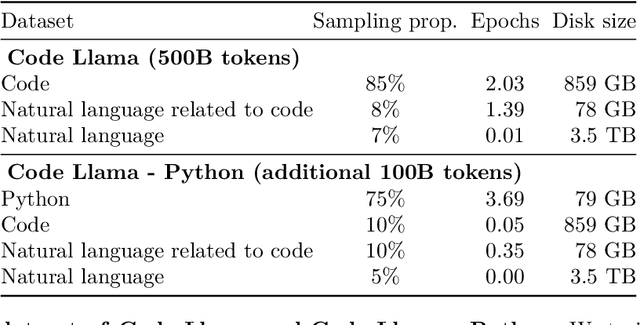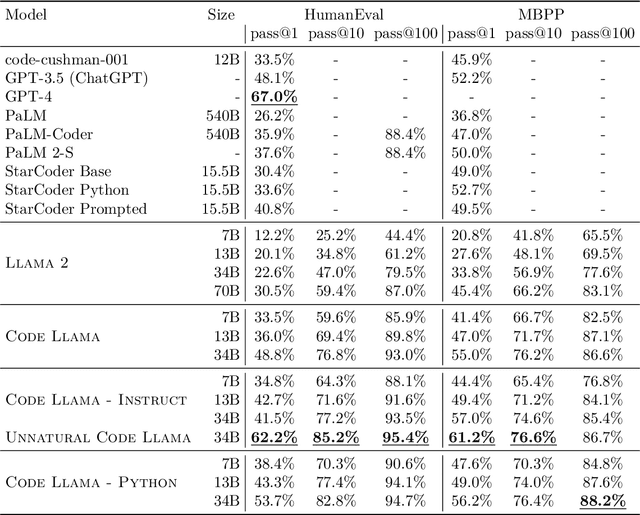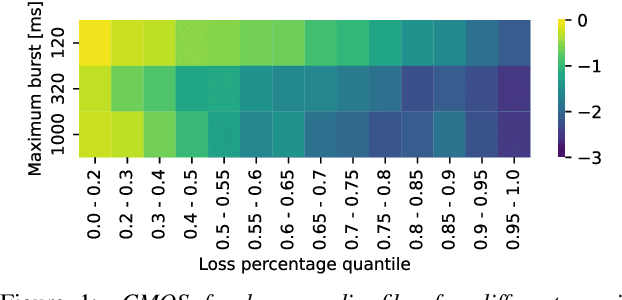Sten Sootla
Jack
The Llama 3 Herd of Models
Jul 31, 2024Abstract:Modern artificial intelligence (AI) systems are powered by foundation models. This paper presents a new set of foundation models, called Llama 3. It is a herd of language models that natively support multilinguality, coding, reasoning, and tool usage. Our largest model is a dense Transformer with 405B parameters and a context window of up to 128K tokens. This paper presents an extensive empirical evaluation of Llama 3. We find that Llama 3 delivers comparable quality to leading language models such as GPT-4 on a plethora of tasks. We publicly release Llama 3, including pre-trained and post-trained versions of the 405B parameter language model and our Llama Guard 3 model for input and output safety. The paper also presents the results of experiments in which we integrate image, video, and speech capabilities into Llama 3 via a compositional approach. We observe this approach performs competitively with the state-of-the-art on image, video, and speech recognition tasks. The resulting models are not yet being broadly released as they are still under development.
Code Llama: Open Foundation Models for Code
Aug 25, 2023



Abstract:We release Code Llama, a family of large language models for code based on Llama 2 providing state-of-the-art performance among open models, infilling capabilities, support for large input contexts, and zero-shot instruction following ability for programming tasks. We provide multiple flavors to cover a wide range of applications: foundation models (Code Llama), Python specializations (Code Llama - Python), and instruction-following models (Code Llama - Instruct) with 7B, 13B and 34B parameters each. All models are trained on sequences of 16k tokens and show improvements on inputs with up to 100k tokens. 7B and 13B Code Llama and Code Llama - Instruct variants support infilling based on surrounding content. Code Llama reaches state-of-the-art performance among open models on several code benchmarks, with scores of up to 53% and 55% on HumanEval and MBPP, respectively. Notably, Code Llama - Python 7B outperforms Llama 2 70B on HumanEval and MBPP, and all our models outperform every other publicly available model on MultiPL-E. We release Code Llama under a permissive license that allows for both research and commercial use.
PLCMOS -- a data-driven non-intrusive metric for the evaluation of packet loss concealment algorithms
May 24, 2023Abstract:Speech quality assessment is a problem for every researcher working on models that produce or process speech. Human subjective ratings, the gold standard in speech quality assessment, are expensive and time-consuming to acquire in a quantity that is sufficient to get reliable data, while automated objective metrics show a low correlation with gold standard ratings. This paper presents PLCMOS, a non-intrusive data-driven tool for generating a robust, accurate estimate of the mean opinion score a human rater would assign an audio file that has been processed by being transmitted over a degraded packet-switched network with missing packets being healed by a packet loss concealment algorithm. Our new model shows a model-wise Pearson's correlation of ~0.97 and rank correlation of ~0.95 with human ratings, substantially above all other available intrusive and non-intrusive metrics. The model is released as an ONNX model for other researchers to use when building PLC systems.
INTERSPEECH 2022 Audio Deep Packet Loss Concealment Challenge
Apr 11, 2022


Abstract:Audio Packet Loss Concealment (PLC) is the hiding of gaps in audio streams caused by data transmission failures in packet switched networks. This is a common problem, and of increasing importance as end-to-end VoIP telephony and teleconference systems become the default and ever more widely used form of communication in business as well as in personal usage. This paper presents the INTERSPEECH 2022 Audio Deep Packet Loss Concealment challenge. We first give an overview of the PLC problem, and introduce some classical approaches to PLC as well as recent work. We then present the open source dataset released as part of this challenge as well as the evaluation methods and metrics used to determine the winner. We also briefly introduce PLCMOS, a novel data-driven metric that can be used to quickly evaluate the performance PLC systems. Finally, we present the results of the INTERSPEECH 2022 Audio Deep PLC Challenge, and provide a summary of important takeaways.
AECMOS: A speech quality assessment metric for echo impairment
Oct 08, 2021



Abstract:Traditionally, the quality of acoustic echo cancellers is evaluated using intrusive speech quality assessment measures such as ERLE \cite{g168} and PESQ \cite{p862}, or by carrying out subjective laboratory tests. Unfortunately, the former are not well correlated with human subjective measures, while the latter are time and resource consuming to carry out. We provide a new tool for speech quality assessment for echo impairment which can be used to evaluate the performance of acoustic echo cancellers. More precisely, we develop a neural network model to evaluate call quality degradations in two separate categories: echo and degradations from other sources. We show that our model is accurate as measured by correlation with human subjective quality ratings. Our tool can be used effectively to stack rank echo cancellation models. AECMOS is being made publicly available as an Azure service.
 Add to Chrome
Add to Chrome Add to Firefox
Add to Firefox Add to Edge
Add to Edge